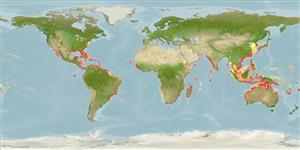Elasmobranchii (sharks and rays) >
Myliobatiformes (Stingrays) >
Myliobatidae (Eagle and manta rays) > Myliobatinae
Etymology: Aetobatus: Greek, aetos = eagle + Greek, batis, batidos = a ray (Raja sp.) (Ref. 45335).
Issue
The species Aetobatus laticeps Duméril, 1865 is considered as valid in Eschmeyer (CofF ver. Mar. 2011: Ref. 86697) according to White et al. (2010: Ref. 84291) where it is questionably valid.
Environment / Climate / Range
Ecology
Marine; brackish; benthopelagic; amphidromous (Ref. 51243); depth range 1 - 80 m (Ref. 9710), usually 1 - ? m (Ref. 55257). Subtropical, preferred ?
Atlantic and Eastern Central Pacific.
Length at first maturity / Size / Weight / Age
Maturity: Lm 99.8, range 110 - 120 cm
Max length : 330 cm WD male/unsexed; (Ref. 58048); common length : 180 cm WD male/unsexed; (Ref. 6871); max. published weight: 230.0 kg (Ref. 7251)
Short description
Morphology | Morphometrics
Dorsal
spines
(total): 0;
Dorsal
soft rays
(total): 0;
Anal
spines: 0;
Anal
soft rays: 0. An eagleray with a long snout, flat and rounded like a duck's bill, a thick head, and a pectoral disc with sharply curved, angular corners, and no caudal fin; jaws usually with single row of flat, chevron-shaped teeth (Ref. 5578). Each tooth a crescent-shaped plate joined into a band (Ref. 26938). Numerous white spots on black or bluish disc; white below (Ref. 5578). Long whiplike tail, with a long spine near the base, behind small dorsal fin. No spines on disk (Ref. 7251).
Commonly found in shallow inshore waters such as bays and coral reefs but may cross oceanic basins (Ref. 9862). Benthopelagic, found near land at 1-60 m (Ref. 58302). Sometimes enters estuaries (Ref. 6871). Swims close to the surface, occasionally leaping out of the water, or close to the bottom (Ref. 3175). Frequently forming large schools during the non-breeding season (Ref. 7251). Feeds mainly on bivalves but also eats shrimps, crabs, octopus and worms, whelks, and small fishes (Ref. 9862). Ovoviviparous (Ref. 50449). Flesh edible (Ref. 30573). Over 3 m disc width and up to 880 cm total length if the long tail is undamaged (Ref. 30573). Bears young in litters of 2-4 (Ref.58048,Ref. 26938). Tail used as a decorative item (Ref. 27550). Common catch of the demersal tangle net, bottom trawl, inshore gillnet and, to a lesser extent, demersal longline fisheries. Utilized for its meat and cartilage (Ref.58048).
Life cycle and mating behavior
Maturity | Reproduction | Spawning | Eggs | Fecundity | Larvae
Exhibit ovoviparity (aplacental viviparity), with embryos feeding initially on yolk, then receiving additional nourishment from the mother by indirect absorption of uterine fluid enriched with mucus, fat or protein through specialised structures (Ref. 50449). Bears up to 4 young (Ref. 5578, 6871, 37816). Width at birth 17-35 cm (Ref. 37816).
According to Uchida et al (1990) (Ref. 51119) 'the male chases the female in mid water, then nibbles on her dorsal surface. The female stops swimming to begin copulation. The male bites the female on a pectoral fin and bends one clasper forward, then attempts an abdomen to abdomen copulation with either clasper, usually mid-water' (Ref. 49562). Copulation lasted for 20 seconds to 1 minute (Ref. 49562).
Last, P.R. and J.D. Stevens, 1994. Sharks and rays of Australia. CSIRO, Australia. 513 p. (Ref. 6871)
IUCN Red List Status (Ref. 115185)
CITES (Ref. 94142)
Not Evaluated
Threat to humans
Traumatogenic (Ref. 4690)
Human uses
Fisheries: minor commercial; gamefish: yes
More information
ReferencesAquacultureAquaculture profileStrainsGeneticsAllele frequenciesHeritabilityDiseasesProcessingMass conversion
Tools
Special reports
Download XML
Internet sources
